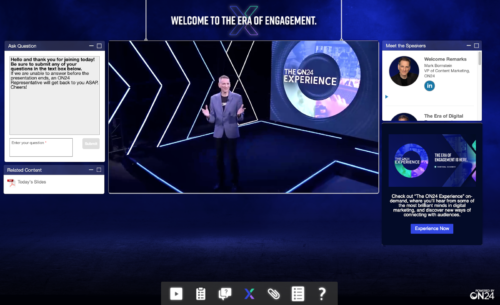4 Branding Tips That’ll Make Your Hybrid Event Stand Out

Face-to-face events are coming back across the world and more and more companies are choosing to lead with a hybrid event strategy, a strategy that promises to meld the benefits of both in-person and remote audiences in a single event experience.
With this shift back into physical spaces comes a new challenge: how to brand your hybrid experience in a way that wows in-person and virtual attendees.
Curious about the best way to design engaging webinars? Watch our on-demand webinar to see how. Watch Now.
For the past year and a half, we have been talking non-stop about how to elevate your brand for virtual events, but now we can finally think outside the confines of our browser to create truly epic brand experiences.
Follow these tips to learn how to create a consistent experience that showcases the best of your brand for both physical and digital audiences.
Tip #1: When it comes to hybrid events, Think Digital-First

Hybrid, digital, in-person… no matter what your event type is, branding will almost always begin with digital components in your promotional strategy.
Before you can even think about how to wow your attendees, you need to start by wowing the general public. This means creating an event brand that stands out in your most important digital channels.
When working with your creative team to develop the look and feel, think through the channels where your event will be promoted, as well as what other events are being advertised to the same audience.
Pay attention to ads that you’re being served and build an event brand that can stand out against those on mobile ads, email banners and on social media to help drive registrations from the right audiences.
This means creating a look and feel with clear messaging, CTAs and a distinct and memorable look and feel that can be elevated beyond just promotional assets.
Tip #2: Brand Your Physical (Hybrid event) Space

Once the look and feel for your event has been established and you’re driving registrations, you will want to think through the branding of your physical space first.
Why physical? The physical space typically has a lot more variables of decision-making that need to occur depending on your event production.
Start with the presenting location: will this be a ballroom stage, a studio, a conference room? If you have the budget, consider adding custom lighting and backdrops that will sit behind your presenters as this will reach your digital audience as well as in-person through your broadcast.
Beyond the presenting location, think about all of the other areas your in-person audience will wander at your venue, like registration, lunch areas, the tables within the presenting space, even restrooms!
Depending on the venue and budget, you can add signage throughout as needed to bring your event to life while continuing to connect your brand to your audience.
Tip #3: Consider Your Physical Branding When Building the Digital Branding

Once your physical event branding is locked, you can begin to think through what the digital experience will look like.
We recommend evaluating digital branding after you’ve established the physical components so that any branding that has been added into the presenter production at the venue can be considered.
Let’s start with your digital event console.
You want to treat the branding for this much like you are treating the “room” that your in-person attendees are in. Ask yourself:
-
- What is the base look and feel that is on the signage or walls?
- What do they have at their tables?
- Is there anything for them to read or interact with?
Take those same considerations for your digital audience by extending the same branding to the background of your console and adding a Call-to-Action or two or supporting documents into the Related Content tools.
Hybrid Brand Considerations
You also want to consider the stage or presenting location that we mentioned in our second tip.
How you branded that area will inform how you brand your digital experience — especially when it comes to avoiding duplicate messages. For example, if you have a big event logo sitting behind the presenter in the broadcast, maybe you don’t need it in your digital event console as well.

By considering the branding of both locations together, you can create a more streamlined brand for both audiences.
Just like you have thought through other areas of the venue that your in-person audience will venture to, you should do the same for your digital audience!
Think through how they are entering the event and extend your event branding to the virtual lobby. Think about where they are going from the experience. What are the key CTAs that you are pointing someone to next?
If you are pointing to a product demo or another registration from your digital event, consider creating a specific page just for that event that speaks directly to the audience and matches the experience visually to reduce brand friction.
Tip #4: Look for Opportunities to Connect Hybrid Experiences

Finally, once you have planned out the branding of your physical and digital environments, think through other ways to connect your dispersed audience. For example, swag.
Swag has been a staple of in-person events for a long time and is a great way to leave your audience with a physical reminder of the event that occurred.
Try extending this same takeaway to your digital audience by adding a redemption link to your digital event for post-event shipping, or even better, send it pre-event to get your audience excited and remind them to attend.
Wrapping Up The Hybrid Brand Experience

Branding your hybrid event is fundamentally a matter of aligning design to enhance your event’s purpose. Slow down, think things through.
Realize that, often, starting with a digital mindset will help set the tone of your event’s brand and help it draw audiences in for a long time. Then consider the physical elements you’ll need to design with a special emphasis on what will be broadcast to virtual audiences.
Finally, realize that branding a hybrid event means expanding what you normally would do with a purely in-person or digital event. Send swag to virtual attendees. Provide onsite prospects with digital assets. Most of all, have fun and experiment with your brand and your hybrid experience.
